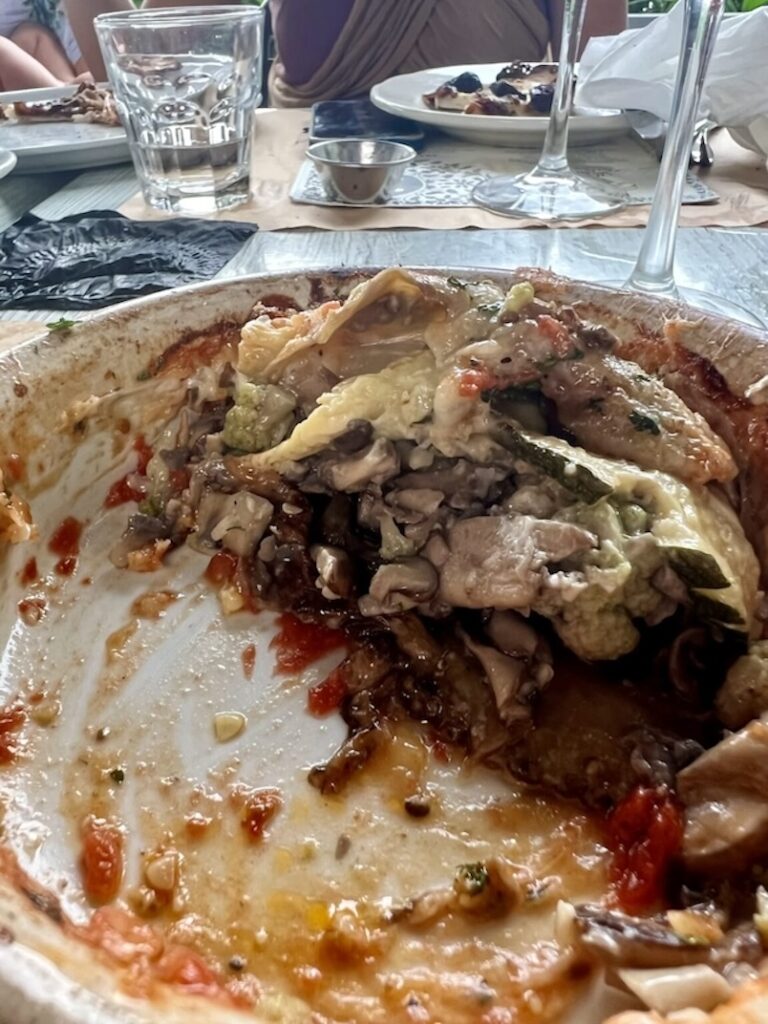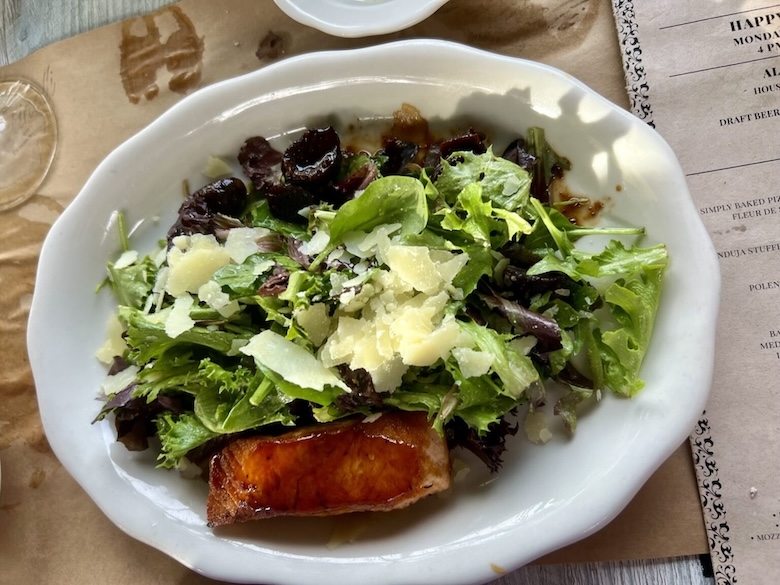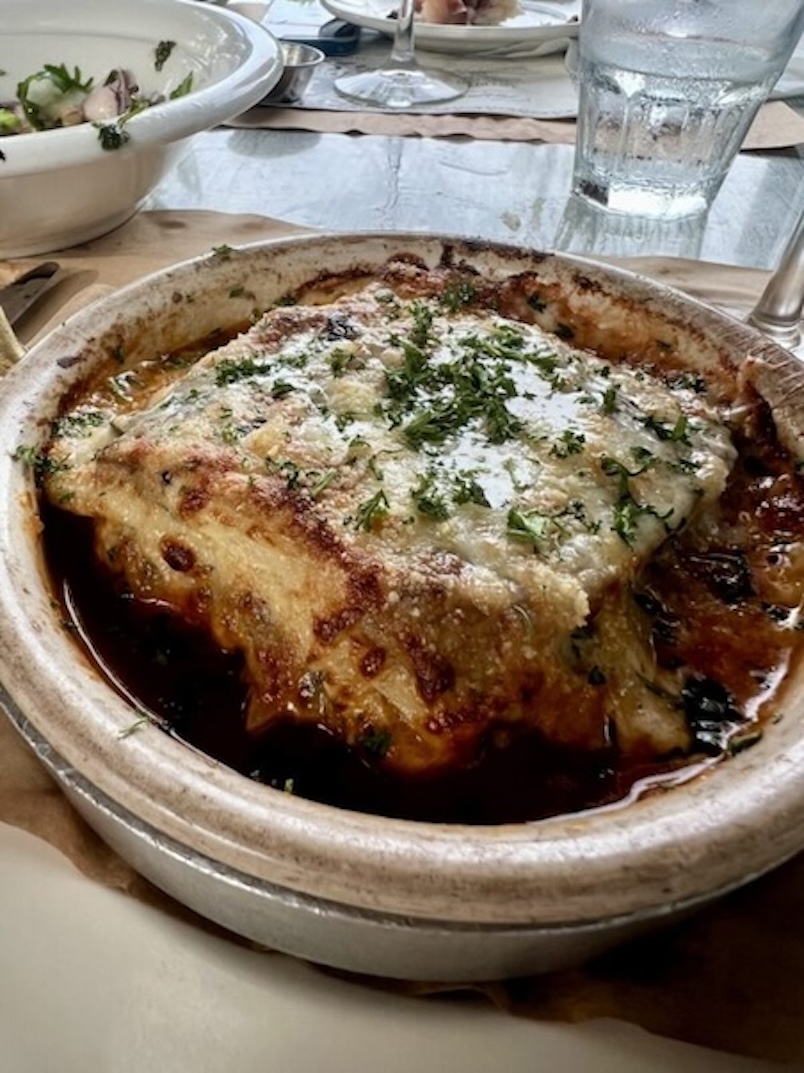When a brunch spot was too crowded for an early lunch, Farinelli 1937 became the second choice that I would highly recommend as anyone’s first choice. Having just had what I dubbed best pizza in Miami, I was avoiding a pizza spot for our next eat-out. While I would love to eat pizza for every meal, I also love to try new things and different types of food. That said, it was so great to see a bit of variety on the menu of a pizza spot, without overwhelming.
We started with an appetizer I would normally never get, the Insalata di Mare, a “salad of the sea.” So many types of full-size seafood on a small plate. Shrimp, calamari, baby scallops with chickpeas, red onions, roasted peppers, covered in extra virgin olive oil and served alongside lemon. Add a slice of crostini with homemade pesto and you have a mixture of the sea and a feast for your eyes:

It was, as you expect, all of the natural flavors of the ocean. With very little seasoning or spice, I realized that’s what a seafood lover would want here. Authentic taste with a garnish or sprinkle of lemon. This was just not for me. The textures, slimy and chewy, with the visuals of the calamari had me looking away. A nice thing to try, but I filled my plate with appetizer two: the Stracciatella.
Stracciatella cheese, 18-month aged prosciutto di parma, and red wine jam served with more crostini. Miami loves their burrata (as do most places) but Stracciatella is worthy of having its own moment. Fresh mozzarella is stretched and pulled until it becomes a soft, stringy texture. Then, it’s mixed with cream, creating a luscious, gooey masterpiece. Stracciatella actually means “little shreds” in Italian, which perfectly describes its torn, delicate texture.
The taste is creamy, mild, and with a hint of sweetness. Think soft, silky, and a tad indulgent. Spread over the toasted bread and with a drizzle of the red wine jam, I was happy to let the others focus on the seafood salad so I could have this beauty all to myself:

For a main, I decided to get something I normally wouldn’t: Lasagne di Verdure, or vegetable lasagna. Vibrant layers of grilled eggplant, zucchini, broccoli, and mushrooms make up this veggie version. Cover with parmigiano and add pomodoro basil sauce between those glorious sheets of pasta and you have what may be the most fresh take on the hearty dish.
The below may look like an absolute mess (the first hero image is of the dish not half devoured) but I wanted to show how full this lasagna is. No meat? No worries. It was so filling, literally with its fibrous ingredients, and also bursting with the ingredients. The flavors themselves were a perfect blend of savory, slightly sweet, and comforting goodness, with a cheesy finish that adds that perfect touch. The layers also weren’t soggy, with the veggies roasted to remove moisture and a thicker tomato sauce to hold it all together. I believe this was my first time having a vegetable lasagna and it won’t be the last.

Continuing to avoid the temptation of pizza, we tried one more main that seemed to satisfy the “healthier” requirements: the Salmone e Fichi. I am so glad we did. Some of the best ingredients would, of course, make for such a great salad.
Salmone e Fichi translates to “Salmon and Figs.” It’s a delightful combination of rich and sweet, savory and fruity notes, in a delicious and sophisticated dish. Here, mixed baby greens are topped with soy and sesame oil glazed Faroe Island Salmon then the poached sun-dried figs are added with pecorino sardo, plus a side of lemon-mustard dressing.
Three things I’d love for you to know about this salad:
1. Poached sun-dried figs have a different texture compared to fresh ones. They are chewy, somewhat leathery, and can have a bit of a sticky exterior due to the poaching process. They also have a more intense taste.
2. Pecorino sardo hails from the island of Sardinia in Italy. The cheese is made from sheep’s milk, adding a distinctive richness and depth to its flavor. It’s very versatile to grate over pastas or salads like this.
3. Faroe Island salmon is superior to others. The salmon is raised with a “no antibiotics” policy. The fish are given ample space and time to grow naturally, without the need for antibiotics. This approach contributes to the salmon’s distinct taste and quality. Plus, nestled between Iceland and Norway, boast some of the cleanest and coldest waters in the world. These icy, nutrient-rich waters create an ideal environment for salmon to thrive, giving them a unique and clean flavor.
Take that in, and enjoy in the simplicity:

Like I started, this was a second option for brunch that I would gladly have top of mind for the next gathering. Then, I’ll be sure to space out the pizza stops. With an 800F custom-made copper-coated wood-burning oven, homemade dough, and fresh local ingredients, I’m sure their pizza is worth a visit, plus got to come back and try some of the other traditional Italian favorites.

